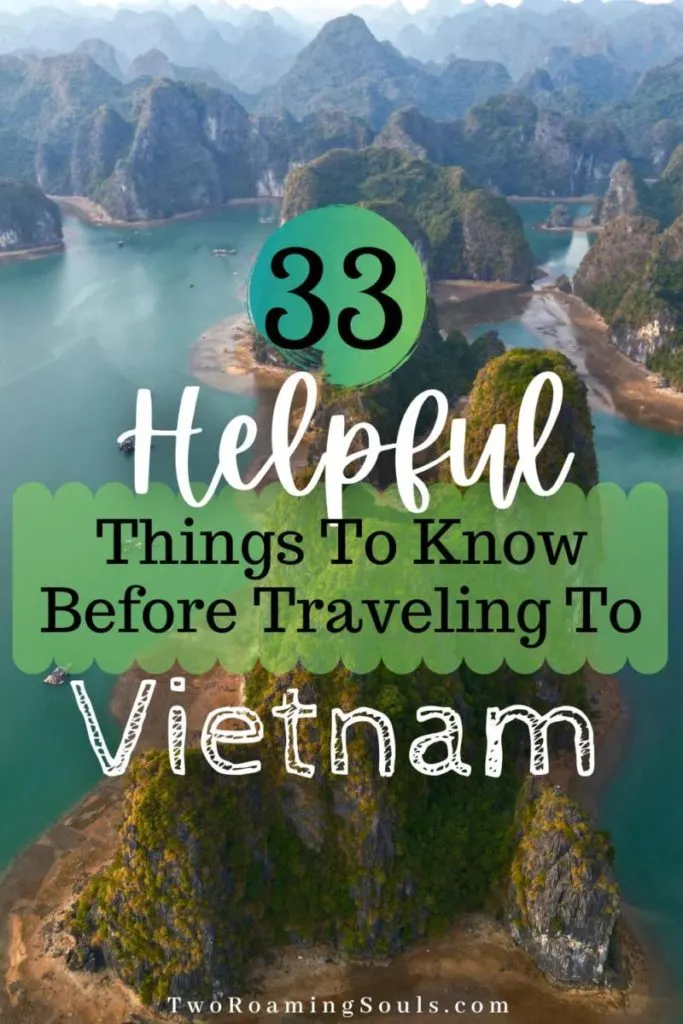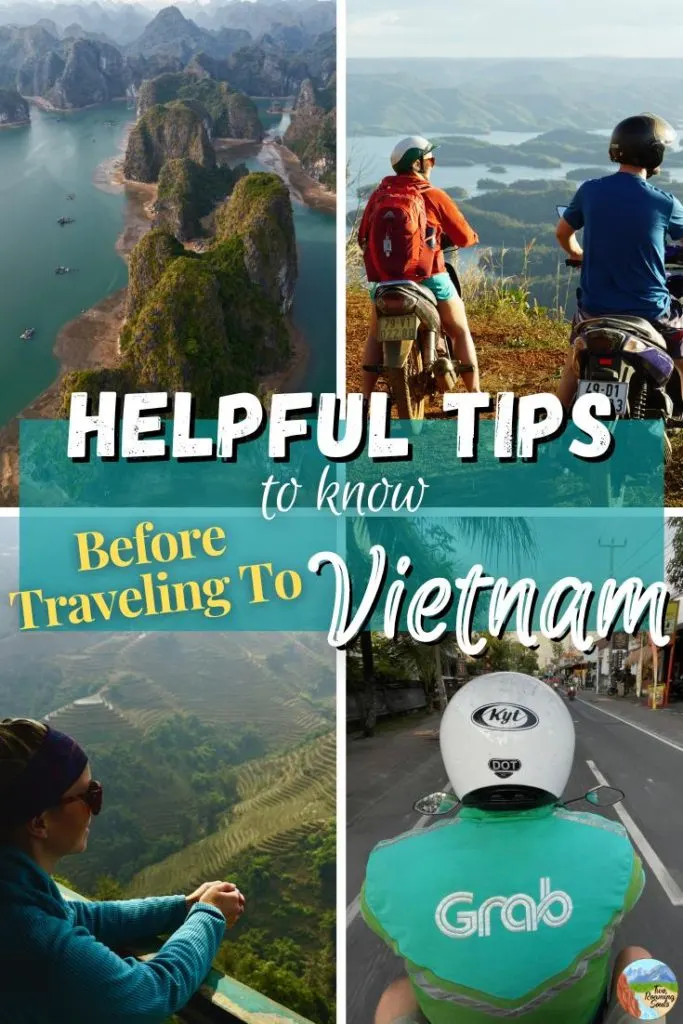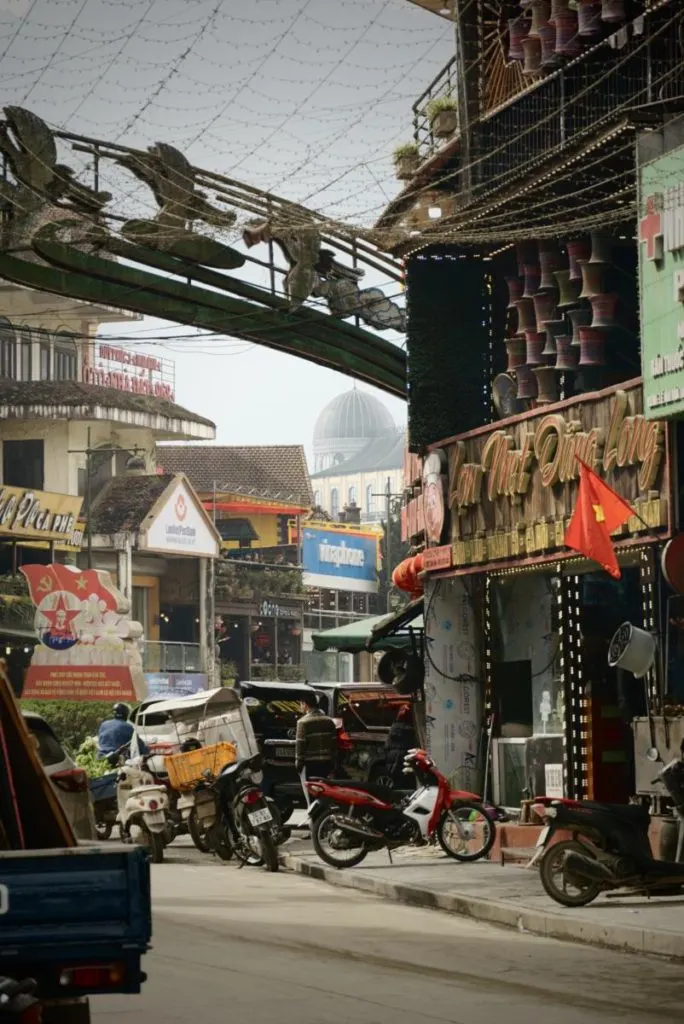
Traveling abroad to Vietnam can be one of the coolest experiences, but it can also be pretty intimidating for first-time travelers. This guide will cover various things to know before traveling to Vietnam to make your trip a success. Personally, these are many things I wish I knew before traveling to Vietnam to better prepare myself for these potential culture shocks.
Ultimately, this guide will help ease any stress you have about traveling abroad to Vietnam. So if you follow these helpful tips, you can ultimately save money and be prepared to tackle this new country before even taking off.
Do note, many of these tips are especially aimed at tourists traveling to Vietnam from the United States (since that’s what we know). But these can also be helpful no matter what country you are traveling from.
This post may contain affiliate links. Disclosure policy.
Apply for an E-visa Before Traveling To Vietnam
Make sure you apply for a visa before traveling to Vietnam. It will make the entry process WAY smoother.
All non-Vietnamese residents will need a visa to enter the country of Vietnam. The easiest way to apply for a visa is online. But you can also apply by mail or e-mail.
Here is the Official Vietnamese Immigration Website. Do not be fooled by other websites trying to charge you extra.
- Open the official website for Vietnam’s e-Visa Application
- Upload .jpg images of your passport data page and passport photo
- Fill up all required info from your passport data page
- Fill up all required info regarding your trip
- Pay the e-Visa fee using any of the payment methods offered
- Receive your registration code and save the number
You can check your application status here: https://evisa.xuatnhapcanh.gov.vn/web/guest/tra-cuu-thi-thuc
Once all the proper information is submitted, it typically takes 3 business days for approval.
A tourist visa is only granted for 30 days in the country. The cost for a Vietnamese Tourist visa is $25 USD.
You can extend a tourist visa close to expiration, but it will require extra work. Typically, tourists can stay no longer than 90 days in a consecutive year. Speak to the embassy for more details on a longer tourist visa.
Be sure to PRINT your visa before traveling! They will ask for it at the customs desk. We suggest also having an extra copy just in case.
Also, make sure your passport won’t expire within 6 months.
Exchange Cash Before Coming
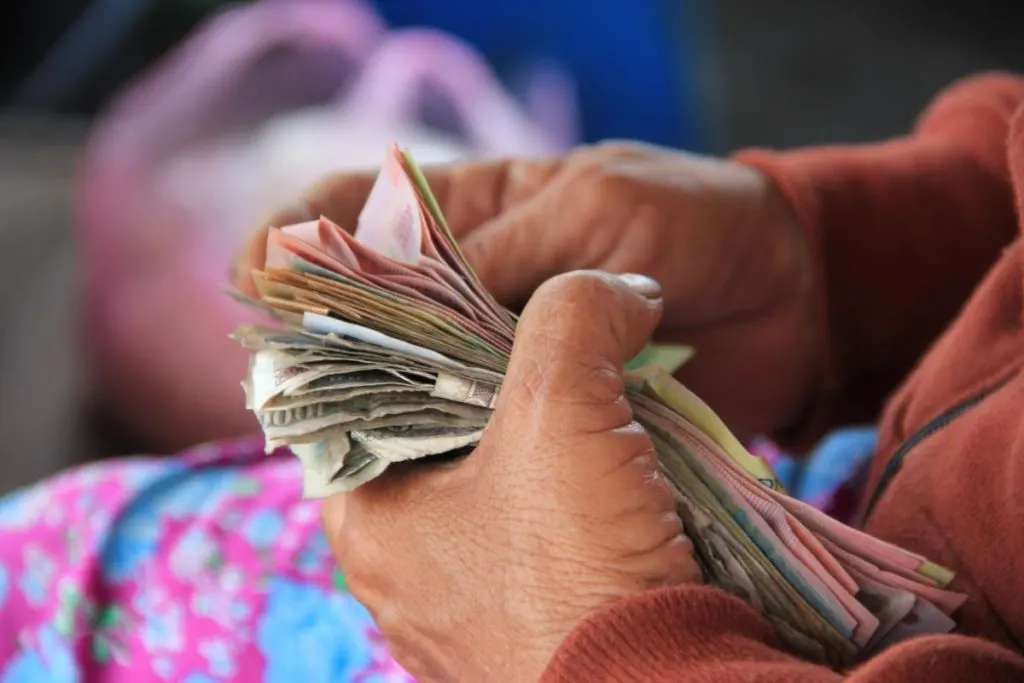
It’s best to exchange cash with your local bank before traveling to Vietnam. While there are ATMs at the airports, they will often have a bad exchange rate.
The local currency in Vietnam is called the Vietnamese Dong. One U.S. Dollar is equivalent to around 23,640 VND (as of July 2023).
When flying into the major cities like Hanoi or Ho Chi Minh City (aka Saigon), you are actually about 30 minutes from the city center. The areas surrounding the airport are actually pretty rural (especially Hanoi) and often don’t have ATMs.
So for example, we got into Hanoi around 10pm and stayed at a small hotel just 5 minutes from the airport (which provided a complimentary shuttle service). When we went to grab breakfast the next morning, we couldn’t find anywhere to take out or exchange money. And there weren’t any local restaurants that would accept credit cards. The hotel staff told us we would need to taxi back to the airport or into Hanoi center to find an ATM.
But this also meant we didn’t have money for a taxi to get to the airport or into the city to our next hotel. Luckily, our hotel had a connection with a taxi driver where we could pay the hotel via credit card and they would pay the driver.
For peace of mind, definitely have at least a little Vietnamese currency to pay for things when you arrive.
“Choose Local Currency” When Taking Money Out Of An ATM
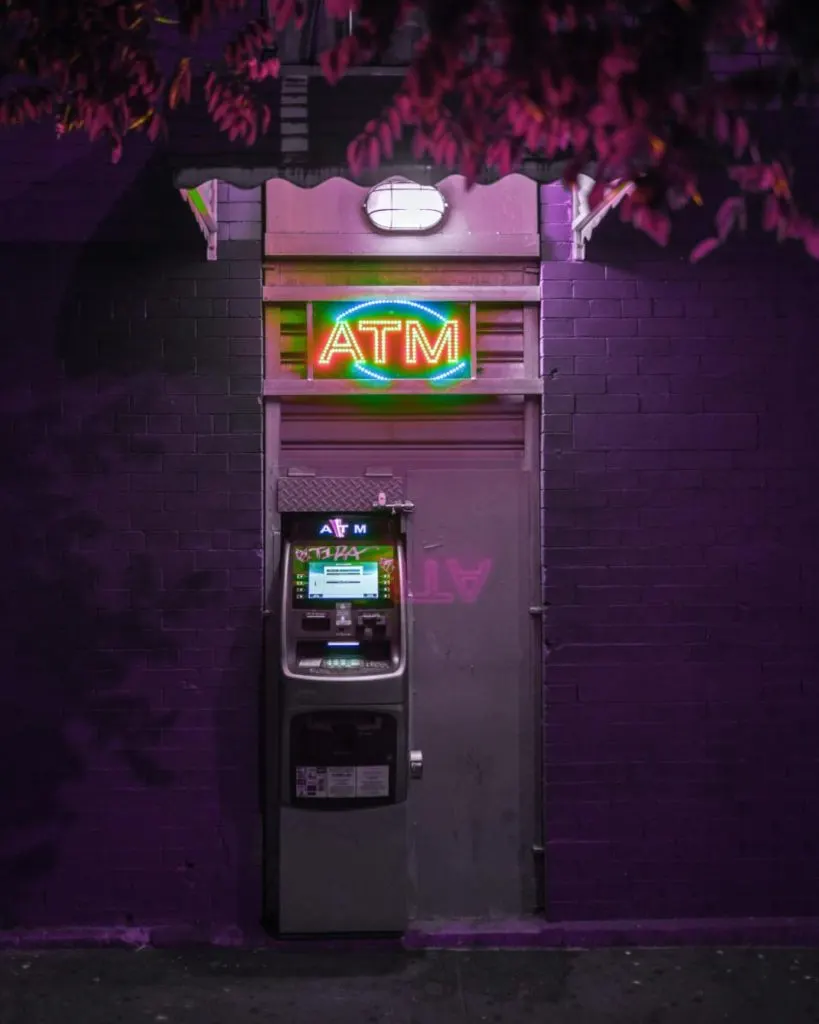
Oftentimes, when taking money out of an ATM, you will get the question, charge in local currency or home currency (in my case USD). Always choose local currency.
This leaves the exchange rate up to your home bank versus the bank of ATM. If you choose your home currency, the local bank will do the exchange rate and might charge an increased rate that makes them the most money, essentially screwing you over.
Choosing “charge me in the local currency” allows your home bank to make the exchange rate which will typically just be the standard exchange rate. However, this is assuming that you also trust your home bank.
Many ATM’s in Vietnam have a daily withdrawal limit. Typicall it’s 2-3 million ($84-$127 USD) for local banks and 5-10 million ($211-$422 USD) with international bank ATM.
And considering that you pay a flat rate fee at most ATM’s it’s in your best interest to take out larger amounts at oncce
$100 Bills USD Can Get You An Extra Good Exchange Rate
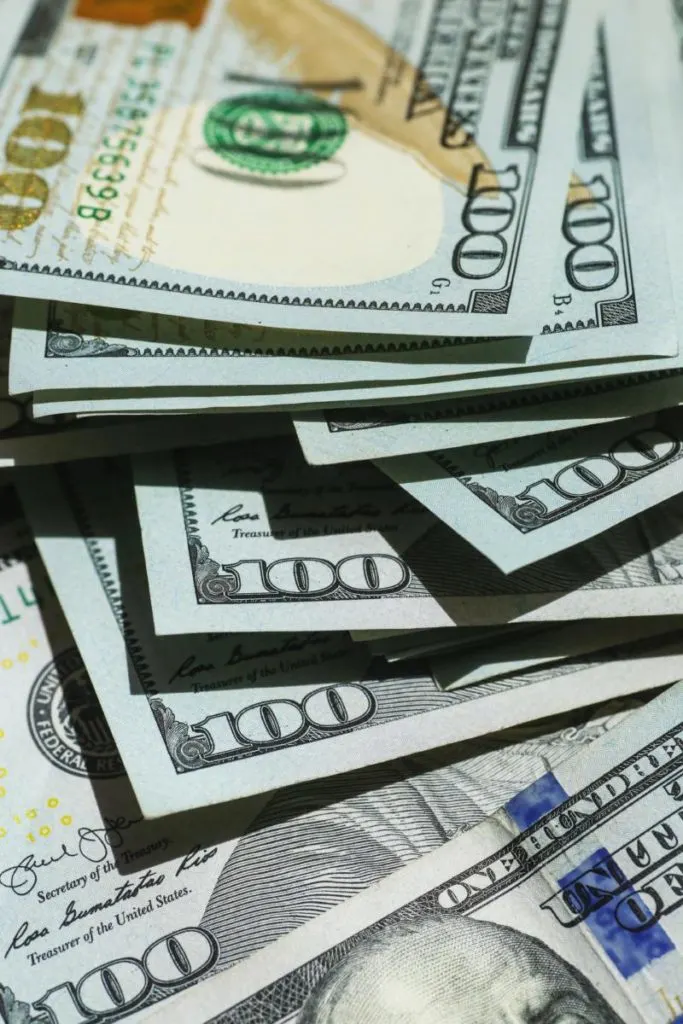
(Photo by Giorgio Trovato on Unsplash)
The United States One-Hundred Dollar Bill is highly valued in Vietnam. Many Vietnamese citizens will keep savings of USD rather than their own currency.
Jewelry stores, pawn shops, and some other local shops will offer an extra high exchange rate for a $100 bill. Oftentimes giving you a better rate than what the bank might offer.
This trick isn’t always a guarantee, but it can definitely be worth a shot. You can ask your hotel, taxi driver, or other tourists if they have advice for where to exchange USD for a good exchange rate.
We also did find it pretty helpful to have USD with us for exchanging at banks so you can avoid foreign transaction fees.
But obviously, take the necessary precautions if you are traveling with a lot of cash.
Find A Bank With No Foreign Transaction Fees
If you travel often or will often be using a credit card or debit card during your travels, it can be helpful to have a bank that doesn’t charge a foreign transaction fee. Or reimburses you if you do pay a foreign transaction fee.
Here is a list of 15 great checking accounts that don’t charge a foreign transaction fee or at least low fees. And here are 9 of the best credit cards that don’t charge a foreign transaction fee.
Download Google Translate for Offline Use
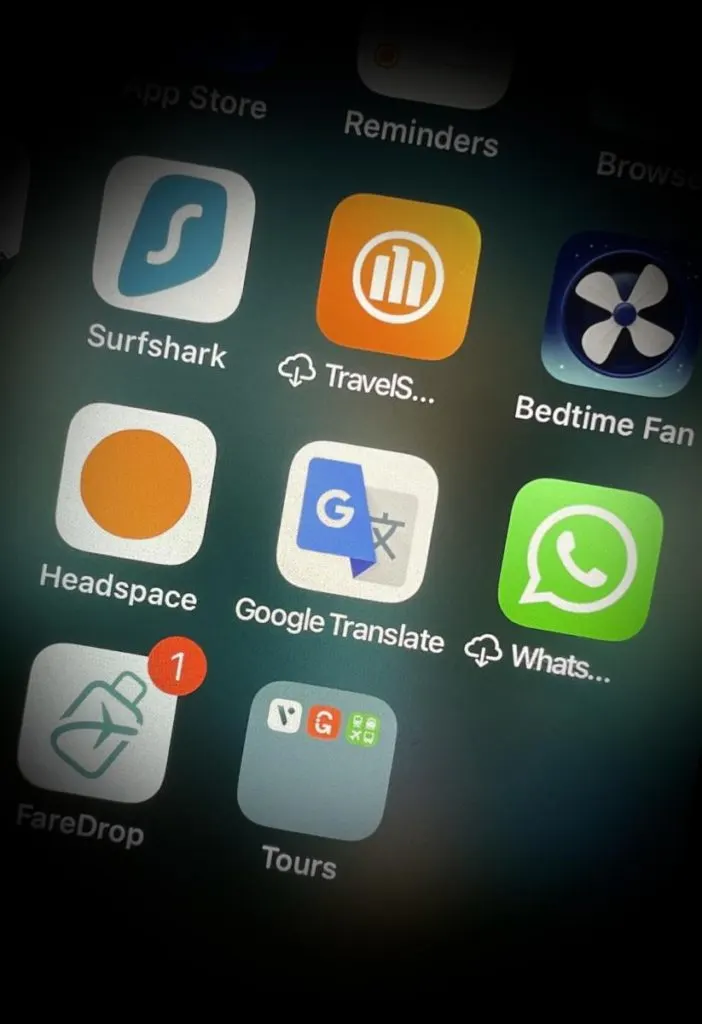
It can be super helpful to download the Vietnamese language on Google Translate for offline use before traveling.
When traveling abroad, sometimes your phone plan might not work right away, or you need to get an e-sim. So it can be super helpful to have a way to communicate with Vietnamese-speaking people.
Fewer people spoke English in Vietnam than we thought. And if they do speak English, it’s pretty broken English. So we used Google Translate multiple times a day with our hotel staff, restaurant servers, taxi drivers, etc.
Google Translate will be the main way you communicate with Vietnamese people. And luckily many Vietnamese people are willing to communicate with the App. We met many Vietnamese people who use it themselves.
You Don’t Need To Know Vietnamese When Traveling To Vietnam, But It Can Be Good To Know Some Phrases
You really don’t have to know much Vietnamese when traveling to Vietnam. But knowing a few phrases can certainly help.
Plus, whenever we did say a phrase it almost always put a smile on a Vietnamese person’s face. They really seemed to enjoy a tourist taking the time to learn a little bit about their culture.
Here are a few helpful Vietnamese phrases:
- Hello – Xin chào – (How it’s pronounced: Seen Jow)
- Goodbye – tạm biệt – (How it’s pronounced: Tam Bee et)
- Thank You – Cảm ơn – (How it’s pronounced: Cam Un)
- Toilet – nhà vệ sinh – (How it’s pronounced: nyeah vay seen)
- Money – tiền – (How it’s pronounced: ting)
- How much – bao nhiêu – (How it’s pronounced: bow niew)
- How much money – Bao nhiêu tiền (How it’s pronounced: bow niew ting)
- Excuse me- Em o’i ((How it’s pronounced: em oy)
- Water – Nước – (How it’s pronounced: new uck)
- Bottled water – chai nước – (How it’s pronounced: Chai new uck)
Vietnamese Numbers:
- 0 (same as no) – không – (Pronounced: khyum)
- 1 – một – (Pronounced: mode)
- 2 – hai – (Pronounced: hi)
- 3 – ba – (Pronounced: ba)
The Vietnamese language is a tonal language, so the inflection of your voice is important for proper communication. Luckily, many Vietnamese people who deal with tourists are accustomed to some common mispronunciations.
The best way to learn the tone is just by speaking the language and having a Vietnamese person speak it back to you! Or you can always put the phrase into Google Translate and it will often spit out the pronunciation of the word or phrase.
Best Time to Visit Vietnam

Well, the answer to this question is all over the board and can be complicated. Typically fall (September to November) and Spring (March and April) are some of the best times to visit Vietnam.
But if you’ve looked at the country of Vietnam, you will realize that it’s HUGE! Think of it similarly to the length of Maine to Florida. So if you are a U.S. citizen, then you know the climates between those states are drastically different.
It’s best to look up the best time to visit each specific city or town you plan to travel to, in order to get the most accurate best time of year.
The Rainy Season in Vietnam is typically from May through November, with the summer months getting the grunt of the heavy rain.
But that doesn’t exactly mean the winter months are the best time to visit either… (more info below)
Burn Season or Pollution
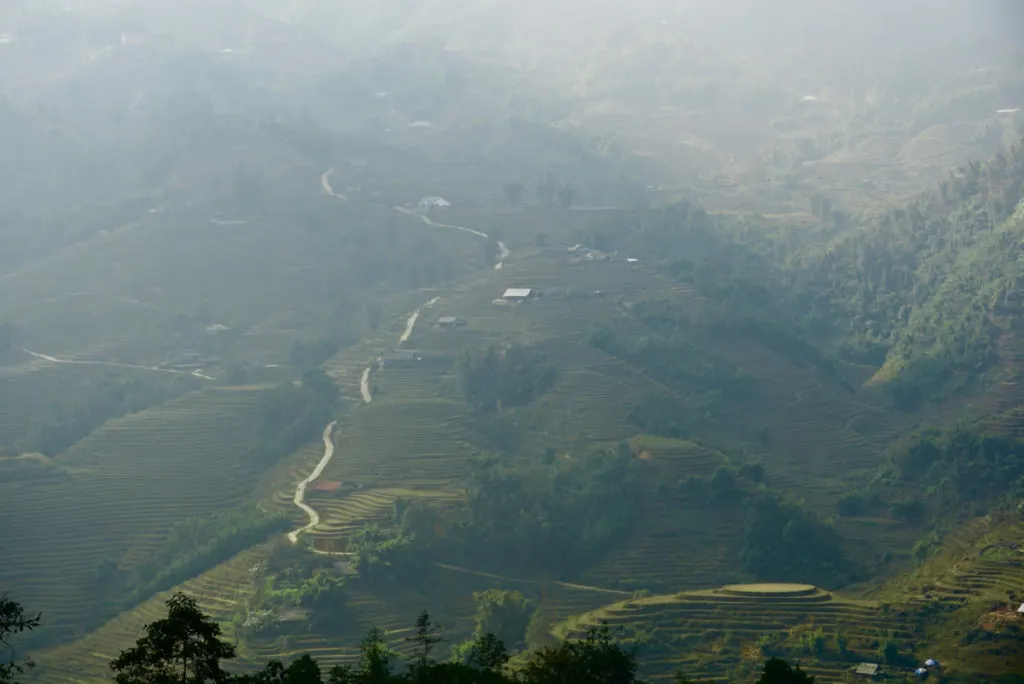
Southeast Asia has a “Burn Season”. This is when many of the farmers will burn the remaining old crops on the farm to start fresh in spring. Which in turn can cause smoke and haziness in the air. Burn season is typically in winter, starting in late January and can last up to 15 weeks.
Burn season causes more air pollution, in a country that already struggles with bad air quality.
You will often see many people wearing masks because of the air pollution.
We visited Vietnam in January and there was heavy pollution in the air for most of our visit (Especially in the north). And this was before “burn season”, so I can imagine it gets way worse for the month of February and early March.
E-sim on Current Cellular Plan
When traveling abroad to Vietnam, we were a little unclear on what phone plan we should choose. We have Verizon for our cell phone provider, but their International Travel Plan was far too expensive for what you get, costing $100 per month or $10/day.
Personally, we knew we didn’t need to call or text with our phones with cellular data. We would just use wifi if we wanted to call or text our friends and family. But we still needed data for the times we were away from Wifi. Which is helpful when we were out and about and wanted to get a taxi or look up directions.
If your phone is compatible with e-sim technology, we find it to be much more convenient than physical sim cards. And many newer phones have dual sim functionality, so you can keep your regular phone plan active and use it on wifi, and also use a separate sim or e-sim for your international data plan.
So we used Maya Mobile e-sim which allowed us to use our current phones but still have data with a local cell tower. You can either choose the local country you are traveling to or choose a general region (such as Asia/Pacific).
The nice thing about this is that the plans are carrier agnostic. Meaning that they will just connect to whichever carrier has the best service in your area.
With Maya Mobile, you can purchase anywhere from 1GB, 3GB, 5GB, 10GB, or unlimited data in a 30-day pass. You can easily add this travel e-sim to your phone and use this as your data when not using wifi.
However, before you go crazy stacking up on unlimited data on an e-sim card, be aware that there is free wifi in almost all hotels, restaurants, shops, etc (more info below).
Wifi is Everywhere (but it kinda sucks!)
Luckily, there is wifi in most places you will visit. But don’t expect high-speed internet.
Free wifi is so available that it might be possible to travel in Vietnam without a local cellular data plan. You can often just use wifi from local shops/hotels to look things up or to help get around the city.
We also found it super easy to guess wifi passwords, because they were often the same and very easy passwords. You can often just try 1-2-3-4-5-6-7-8 or 8-8-8-8-8-8-8-8 and it will work nearly 50% of the time. But there is usually a large sign with the password or you can just ask.
We had heard rumors that the internet was fast in Southeast Asia, but we honestly didn’t really experience this much. Most of our hotels had slow but still “workable” internet. We found it hard to have a fast connection many times throughout our trip. Which sometimes was a detriment for us working remotely on this blog.
Download the Grab App
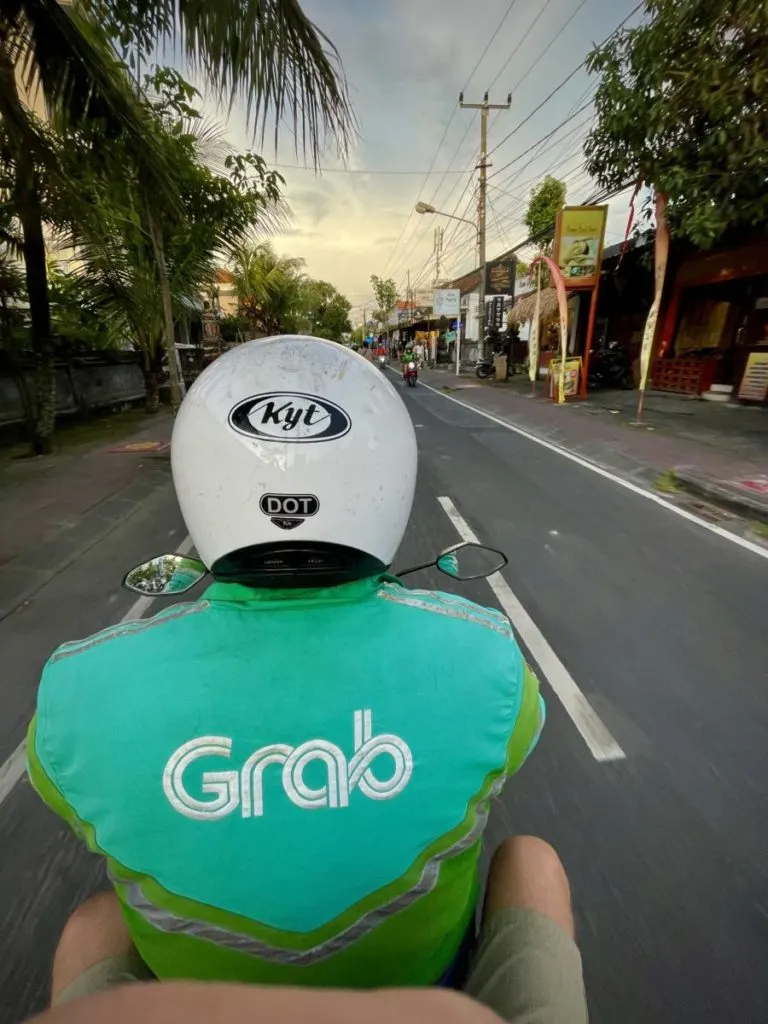
“Grab” is Southeast Asia’s ride-share app. It is the equivalent of Uber or Lyft in America.
You can book rides or also get food delivered via the app. And it is SUPER affordable most of the time! Like way cheaper than taxis. And we were even able to get some meals delivered for under $10 including tax, delivery fees, and tip (for two people).
However, just like in other countries, drivers are sometimes not available in more rural areas.
Grab Versus Taxi
There are safety reasons why using Grab might be better than getting a taxi. And that is because all the drivers go through a background check and driving history check. Additionally, when you book a grab ride, your phone GPS tracks where you are.
And because there might be a language barrier, it was kinda nice to just put in your final address and trust you would make it to the right spot.
Plus it was almost always cheaper to take a Grab than get a taxi. The only downside is you might have to wait a few minutes for your ride to show up, versus a taxi driver being there and ready to drive you straight away.
You Might Not Need A Travel Adapter
We thought travel adapters were a necessity when traveling to Vietnam, but we never once needed one.
The standard outlet they use actually functions as an adapter, accepting several different types of common plugs.
All our hotels, hostels, restaurants, trains, etc always had a Plug Type A (which is the 2-prong plug we use in the USA). But with that being said, I’d still bring one, just in case!
IMPORTANT!! If you have any Type B plugs (plug with 3 prongs), then you will NEED a travel adapter. You will often have this plug for non-macbook laptops.
We brought 3 travel adapters thinking we would need them daily. But they just ended up taking up valuable space in our luggage because they can be pretty bulky.
But one reason why travel adapters can still be helpful is as a sort of power hub. Many hotels had a limited number of outlets available. So we used our travel adapters to charge multiple devices at once from a single outlet.

Which travel adapter you buy should depend on your power needs and which types of outlets you need (USB-A, USB-C, etc). Generally the more power you need, the more expensive they are. Things like laptops and drone batteries can draw a lot of power. But generally you should just plug those devices into an outlet with the regular power supply.
Travel adapters come in lots of configurations, but the one we like best is this travel adapter. It has a good mix USB-C and USB-A, with one USB-C port capable of passing 35 Watts.
If you want a really powerful charger that can charge a laptop, this expensive Epicka Travel Adapter can pass up to 75 watts. Which would be enough to charge a large MacBook Pro allowing you to leave that annoying bulky Apple brick at home.
This is a good value Travel Adapter with plenty of ports from smaller devices.
And lastly, here’s a good Travel Adapter with mostly USB-A ports.
You Might Need A Voltage Converter

Similar to travel adapters, you might consider bringing a voltage converter. In the U.S., the supply voltage is 120V and in Vietnam, the supply voltage is 220V.
Check the voltage supply of your device to see what it supports. For example, my Apple Macbook charger says it supports 100-240V, so that means it will work in both the U.S. and Vietnam without a voltage converter.
The things you need to be most concerned with are heat-creating devices, such a hair straighteners, irons, electric water kettles, etc.
(Be aware that slight variations in voltage are usually not a big concern. For example, 110 volts and 120 volts can be treated equally. The same goes for 220 volts and 230 volts, etc.)
Pretty much all electronic devices state what voltage they accept on the power supply. For every electronic device you plan to bring, check the fine print on the power cord, brick, etc. It will likely say what voltages are accepted.
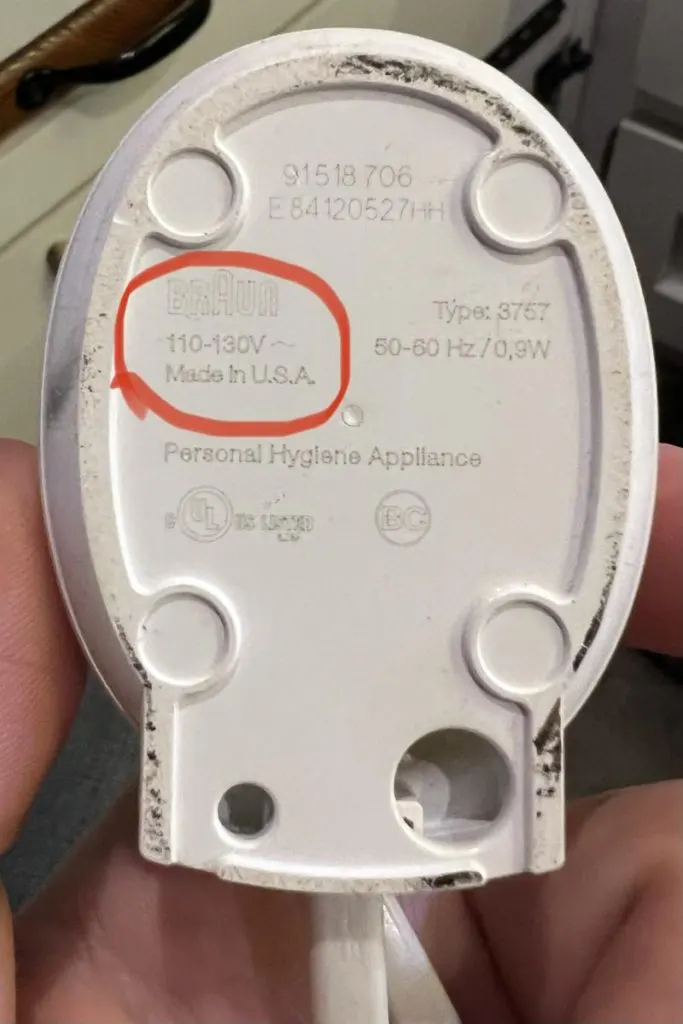
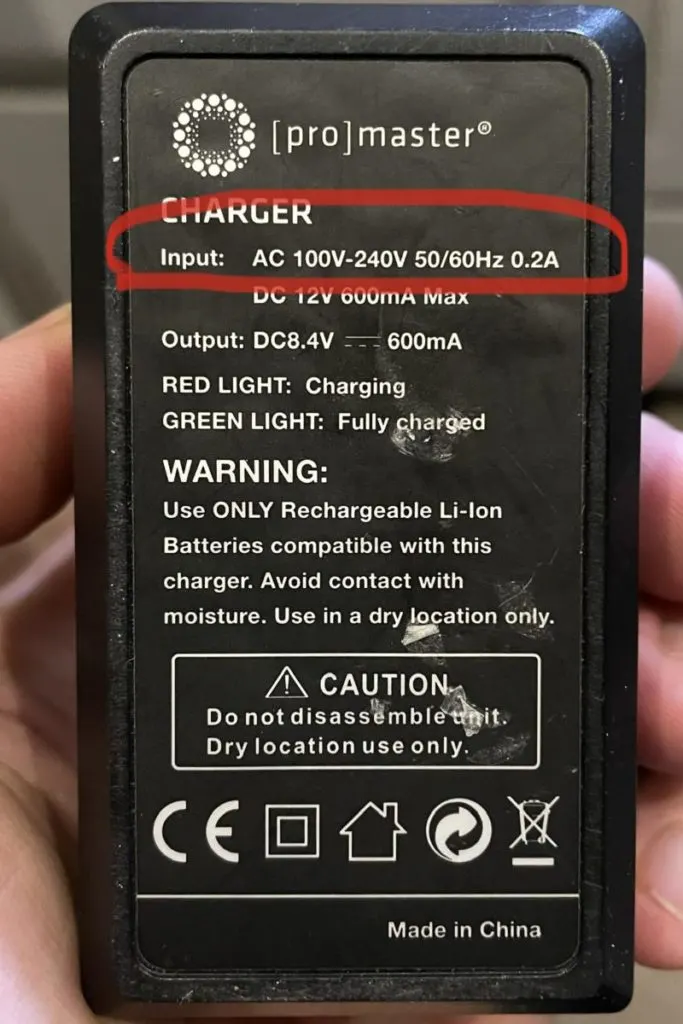
We found that almost all of our electronic devices could support 220V charging. (Cell phones, computers, cameras, headphones, etc).
But my Braun Electric Toothbrush Charger only supports 110-130V. Therefore, if I plug this into a Vietnamese outlet, it will likely fry and become unusable (essentially trash). So this item needs a voltage converter to charge from a Vietnamese outlet.
However, we decided that it was cheaper and easier to just buy a 220-Volt version of our toothbrush charger, rather than buying a bulky voltage converter just for one device.
So there is a chance you can get away with all of your chargers supporting a 220 voltage supply. But I would double-check everything before going. Otherwise having a voltage converter can be exactly what you need to properly power your devices and protect them from frying.
But in our opinion, unless you really NEED them, you a better off just figuring out a way to live without things that need voltage converters.
Bathrooms in Vietnam – Bring TP (remote places don’t have any)
Toilets in Vietnam can be very different than traditional toilets in the U.S. Most hotels will have a traditional toilet, but there are often squatty potties instead of a “westernized” seated toilet. And there is often no toilet paper, just a spray hose.
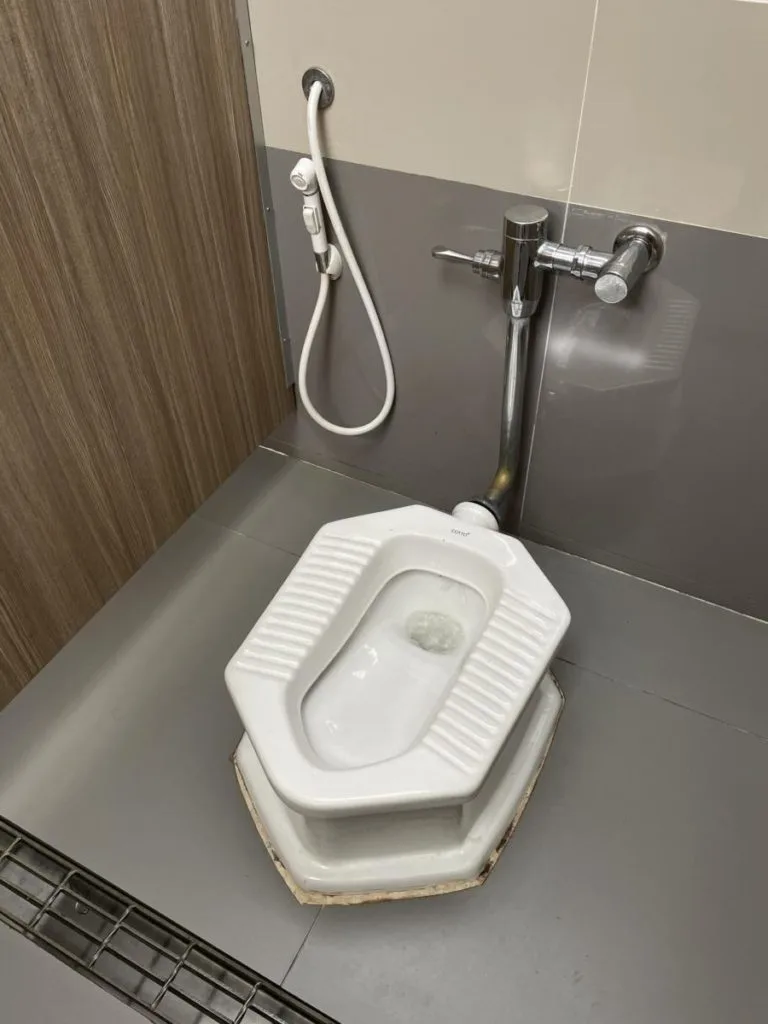
To be honest, Jake and I never really understood the hose much, but it seems to be what most people use in Vietnam culture. It is their version of a Bidet, but not like the elegant and easy-to-use French or Japanese ones.
The Vietnamese Bidet is just a hose and sprayer attached to the wall. I never really liked the fact that everyone touches this after doing their business and puts it very close to their… privates and then just attach it back to the wall. But to each their own!
You also CAN’T flush toilet paper down the toilet like we do in the U.S. All paper products must be put in the trash receptacle. That means #2 TP as well…
You might find 1 roll outside the stalls in the bathroom that you need to grab before going into the stall. But there were many public restrooms that didn’t offer TP at all. So I always carried a little zip lock baggie of toilet paper nearly everywhere when using public restrooms.
Also, many rest stops, bus stations, etc. charge a small fee to use the restroom. (For some reason, I always found these bathrooms to be the most disgusting and unkept, which made no sense since you were paying to use them).
We got in the habit of asking for extra rolls to TP when checking into a hotel, because they rarely provided enough for our American TP habits.
Restaurant Service Is Very Different From The U.S.
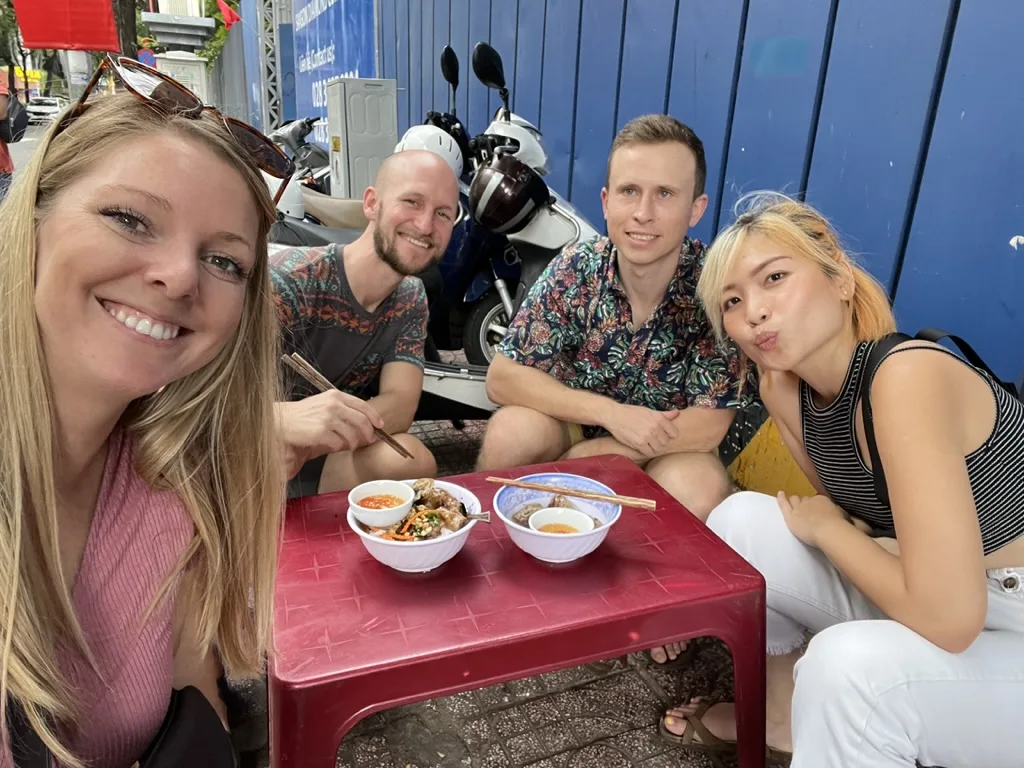
Call for Service
Typically when going out to eat in the U.S. you visit the host/hostess, he/she seats you at a table. Then a server comes to you and takes your order. In Vietnam, there are usually no hosts and you can usually just sit anywhere you like. There might be menus already at the table, or you can grab some on your way in, or call someone over to provide you with a menu.
When you are ready it is your responsibility to call over a server. And typically in the U.S. we get a server’s attention by waiting until they pass close by and make eye contact with you.
In Vietnam, you can call out to a server at any time really, just if they are reasonably close enough to hear you.
This is where it is important to know a little Vietnamese language.
Calling a male or female server who is younger than you = “Em ơi!” (most common)
Calling a female server who is older than you = “Chi ơi!” (
Calling a male server who is older than you = “Anh ơi!”
“Em ơi!” basically translates to “hey dear”, but you can think of it like saying “excuse me”. It’s pronounced exactly how it looks. Em (like Emily) and Oy (like oyster).
“Chi ơi!” is easy too, it’s like pronounced like Chee (as in cheese) and Oy (like oyster).
“Anh ơi!” is a little trickier, Anh is pronounced like a hybrid of “ing” and “ang”, and again Oy (like oyster).
Wait but how do you always know your server’s age and gender just by looking at them?!
We were told that if it’s unclear, then you should always default to ”Em ơi!”
No Paper Napkins
It’s also not customary for Vietnamese restaurants to provide free napkins. They will sometimes provide a wet towelette, but they will charge you for it on your bill.
The wet napkins are nice, but sometimes when your nose is running from a spicy meal you really just need a dry napkin. So as mentioned above about bringing your own TP, this can double as a napkin at times.
Tiny Chairs
Many restaurants in Vietnam, especially street vendors have tiny plastic stools and table. If you are very tall or heavy, you may want to use caution when eating at these restaurants. Or you can seek out more westernized restaurants, which are common in most popular touristy areas.
Food Comes Out When Ready
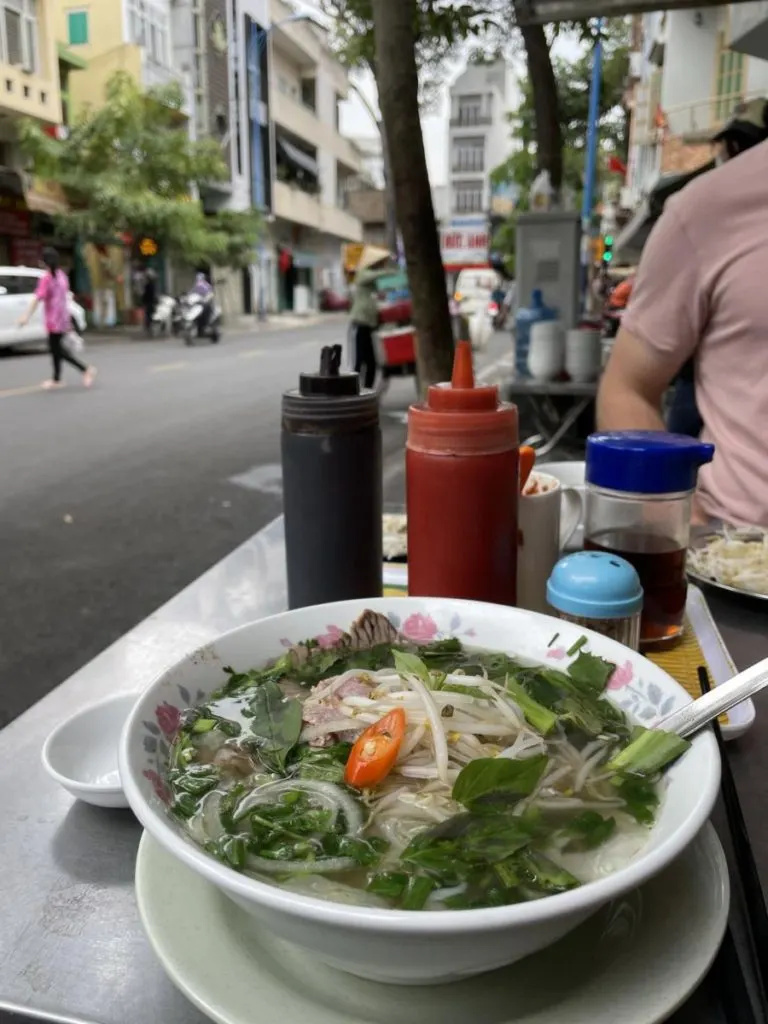
Additionally, food just comes out when it’s ready. Therefore, 1 person might finish their meal before the 2nd person even receives their meal. But this definitely ensures the food is hot when it arrives.
Even if you order an appetizer, there is a chance it shows up after the entrees. And the same goes for cocktails.
So this can be a bit of an adjustment from cultures where meals are always served together to people at the same table.
There is not a whole lot you can do about this one, but maybe if you want an appetizer, just order it completely before mentioning your entrees.
You can be your own time manager at the restaurant, as long as you don’t mind getting the attention of the server multiple times throughout the meal.
No Tipping Required
One of the best perks of eating out in Vietnam is that tipping is not customary. While tips will always be accepted, it’s just an added bonus for the server, rather than in the U.S. where tipping is part of their total income.
We have noticed that tipping is becoming a bit more common in some Southeast Asian countries. So while it’s not customary, a server or taxi driver might see you as a foreigner and kinda expect a little something extra.
Just use your best judgment. If someone helps you out or provides exceptional service, why not make their day and give them a little extra cash!
Hotel Pictures Can Be Misleading
Sometimes the hotel pictures you see on a booking website make the hotels look extravagant. But these photos are often from when the hotel was brand new and in tip-top shape. We noticed many of the hotel pictures made the hotels look WAY nicer than they actually were in person.
They weren’t complete crap holes, but there would often be mold in the bathroom, scratches on the wall, ripped wallpaper, missing furniture or decor, etc. And maybe an air conditioner that has far surpassed its cleaning protocol.
However, keep in mind that we mostly booked the cheapest hotels available (that still had decent reviews). This may be different if you splurge for more expensive accommodation.
Our best advice is to read recent reviews to know what you are actually getting. People aren’t afraid to leave negative reviews to inform future travelers about what to expect upon arrival. Also, covid certainly did not help hotel renovations and updates. So do take this into consideration when hotels maybe need a little updating and maintenance.
Luggage Weight (Pack Less!)
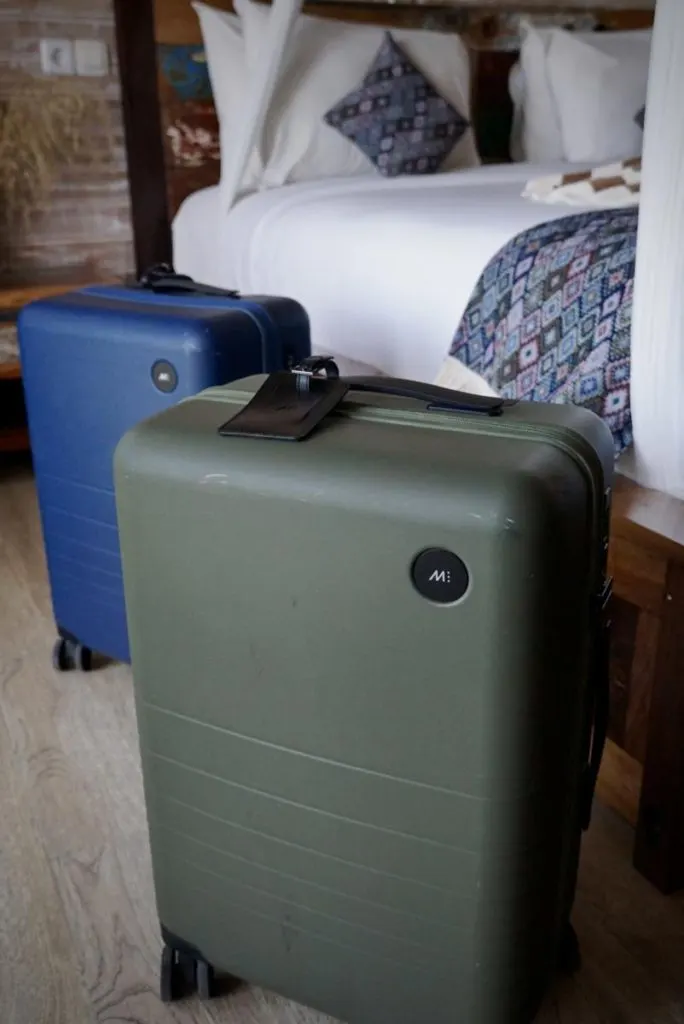
We found ourselves in trouble a couple of times with the weight of our carry-on suitcases. We each travel with the Monos Carry-on Plus (and a backpack). This allowed enough space for us to travel full-time in different climates for 3 months.
But this often surpassed the size requirement and weight capacity a traveler is allowed on many of the Airlines in Southeast Asia. We had to either check our bags (even though they can fit in the overhead bin) or a couple of times, slyly hide the bag as we were checking in.
The weight limit for some Vietnam budget airlines is as low as 15lbs (7kg). This is often the combined weight they allow for both your carry-on and personal item. Which in my mind is nearly impossible.
This was a huge difference from what we are used to on flights in North America, where weight restrictions of carry-ons isn’t really a thing.
We once booked two separate flights with different airlines to save a couple hundred bucks. So we HAD to carry on the bag, otherwise we would have had to leave the airport to go to baggage claim, grab our bag, and re-check it with the other airline, wasting much of our time, and potentially missing the flight. Luckily the lady at the check-in desk showed sympathy and allowed us to carry-on the bag, even though it was technically overweight.
Anyways, just expect to have to check your carry-on or try to keep the weight as minimal as possible.
Pro-Tip: add an AirTag to your carry-on just in case you need to check it.
This can also give you peace of mind when you leave your bag in your hotel room. We really like the Monos bag because it locks. Especially when there was no safe in the room. We knew we could lock our valuables in our suitcase, and when staff would clean our room, they couldn’t snoop through our stuff.
Plus if you pack less from the beginning, you can pick up more souvenirs along your travels! 🙂
Vietnam Snacks Suck!
This sounds a little harsh, but we didn’t find many snacks to taste too good in Vietnam.
Jake and I are used to granola bars, trail mix, jerky, just anything that’s an easy, non-perishable snack but gives you sustenance. But they don’t really carry any of these snack items. Except maybe some nuts.
In Southeast Asian countries we found that it was very common to have seafood-flavored snacks. That just did not jive with us.
We tried multiple different snacks, thinking maybe this will be good. But instead would find corn-flavored rice chips that come in a packet of 2. Basically leaving you more hungry.
Our snacking diet often consisted of Snickers bars and Pringles.
Bring Ziplock Bags
This was advice we got from another travel blogger before traveling to Vietnam. Zip Lock bags do not exist in Vietnam or if they do, they certainly make them hard to find.
This is such an underrated travel tip. This can be nice for packing food, keeping valuables dry on a wet hike, or various other things. It allows you to repackage items so that they fit better in your suitcase
Coffee in Vietnam
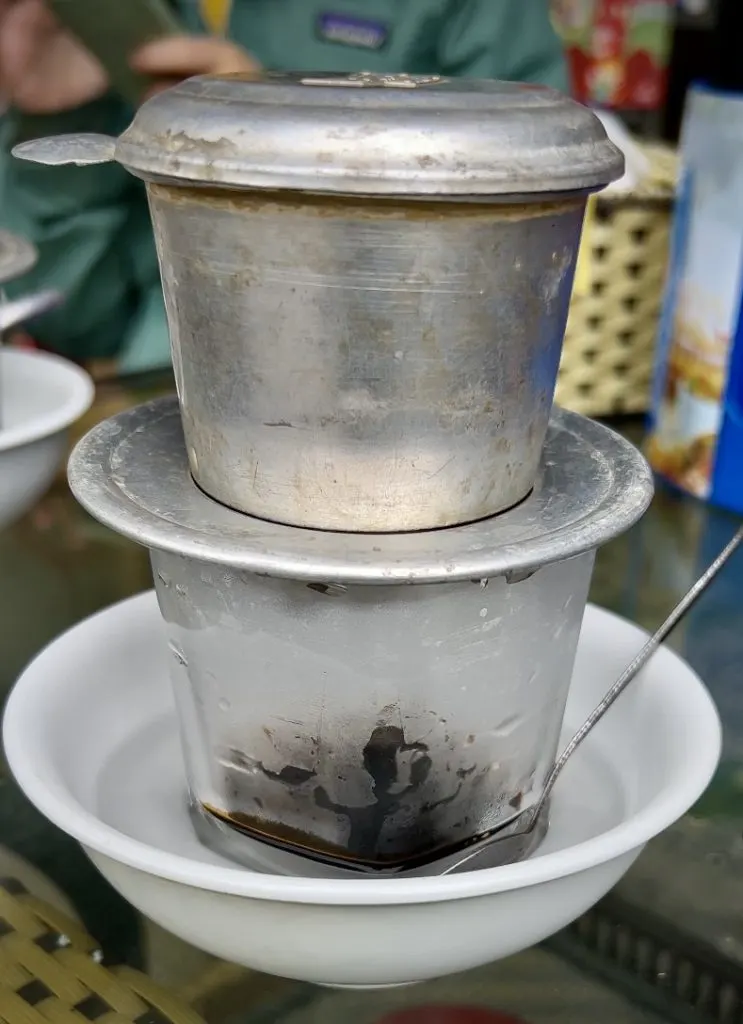
Coffee in Vietnam is very different from traditional black coffee in America. Vietnamese coffee is very strong! And not necessarily in a good way.
Plus Vietnam has a unique twist to coffee called Vietnamese egg coffee (ca phe trung). Traditionally you would get this from a local coffee shop. They mix an egg yolk with sweetened condensed milk to make a creamy specialty drink.
When getting a black coffee made elsewhere, they traditionally just give you sweetened condensed milk to mix with your coffee.
In rural areas, hotels will often just provide “instant coffee” which was basically a sugary drink with little caffeine.
I am a bit of a coffee snob and sadly allergic to eggs, so the coffee in Vietnam wasn’t my favorite.
Be Careful With Street Food
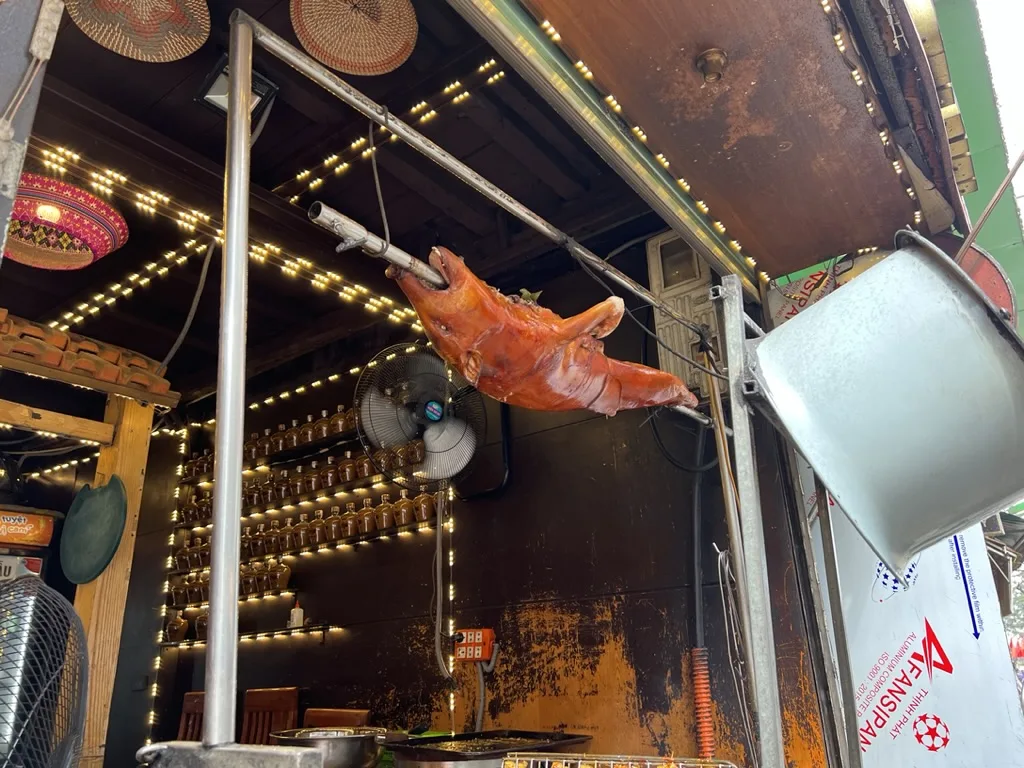
Cleanliness is not exactly Vietnam’s strong suit. They don’t have the same food safety standards that developed countries have.
Restaurants are often cleaning their dishes in a bucket just out on the street.
And there isn’t soap in many of the restrooms… So that makes us think they are not really using something to kill the bacteria on their hands.
For many restaurants in buildings, they probably have a sink and soap to wash hands, dishes, etc.
But for street food vendors who don’t have their own kitchen for preparing and cooking their food, they are likely just using the public restroom for hand washing.
While I’m not suggesting to skip street vendors entirely, just use common sense and be a bit more cautious to maybe exposing yourself to food-borne illnesses.
Don’t Drink The Tap Water
Sadly the tap water in Vietnam is not safe to drink. There have been traces of E. Coli, ammonia, and arsenic often found in the water.
Therefore, you have to buy bottled water. Most hotels will provide a new bottle of water daily, but you obviously drink more than this. So you will often need to stock up at local convenience stores or buy water out at restaurants.
It does become a bit of a chore making sure you always have enough water to drink. But our water consumption is pretty high, about 65oz per day (≈ 2 liters).
Apparently, you can boil the tap water to make it safe for drinking, but I wouldn’t solely depend on this method. You can always boil water and then pair it with a Larq Bottle which kills 99.999% of harmful bacteria found in water.
Can You Brush Your Teeth With The Tap Water in Vietnam?
While many people brush their teeth and wash their face with the tap water in Vietnam with no problems, you might want to be extra cautious to not swallow any water. If you usually rinse your mouth out with water after brushing, maybe use filtered water for that instead.
If you are at all worried, definitely just use bottled water rather than risk it!
We brushed our teeth with the tap water for a month of traveling in Vietnam and never had any problems.
Bring Tums and Imodium
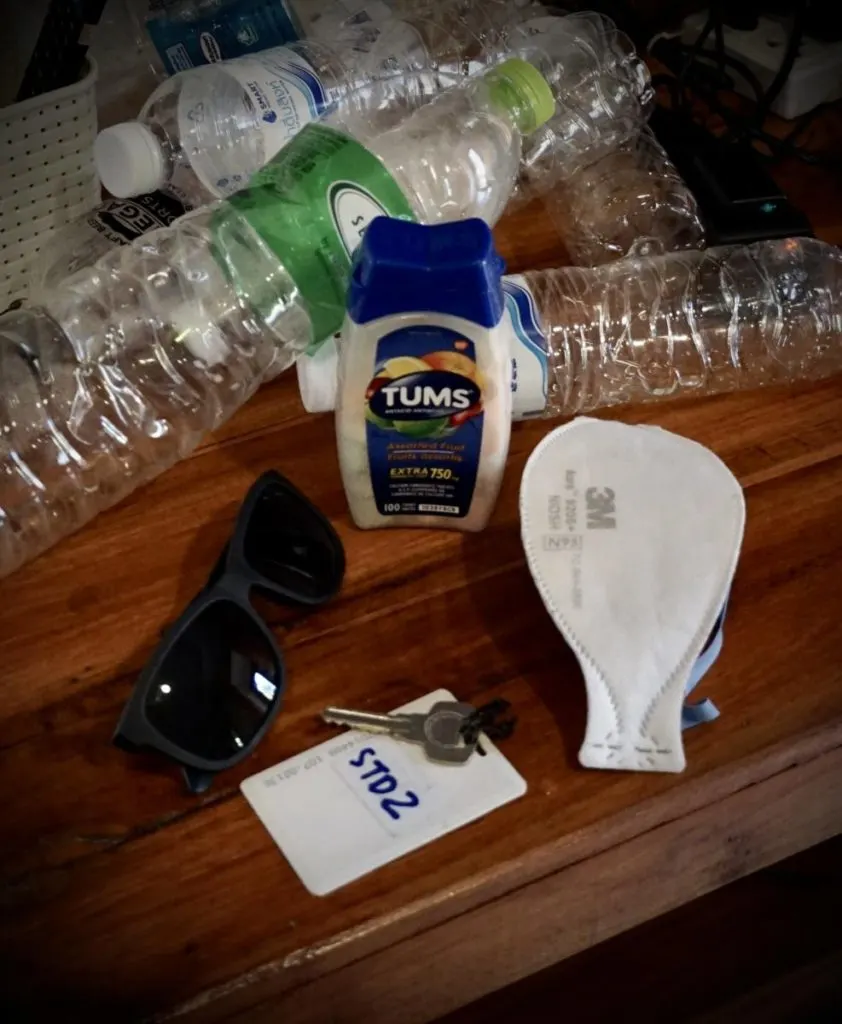
With the above info, this leads me to my next piece of advice when traveling to Vietnam. Stock up on Tums and Imodium. We found it challenging to find some of these products over there. And often it might be called something different or in Vietnamese.
And unless you have a stomach of gold, you will likely experience a couple of stomach…. “episodes” along your trip.
People often refer to stomach issues as “Bali Belly” even though it is technically still in Vietnam.
Get Travel Insurance Before Traveling to Vietnam
If you are a U.S. Citizen, then your health and auto insurance will likely not extend to traveling abroad. So it is best to be prepared with travel insurance.
World Nomads and Allianz are two very popular travel insurance companies.
World Nomads will cover more of the extreme activities. Such as skydiving, trekking, getting bit by a monkey, etc (definitely read the fine print for more details). Because they cover the more extreme activities it will be a bit more expensive.
Allianz is the travel insurance we have. They cover more of the typical issues you might run into. Such as scratches on your rental car, breaking an ankle on a city walking tour, getting a virus and needing medication, etc.
Because we were traveling for multiple months we chose an annual plan. But you can also choose a plan for a shorter duration.
Of course, there are tons of other travel insurance companies to choose from.
Shopping Is Way Different In Vietnam
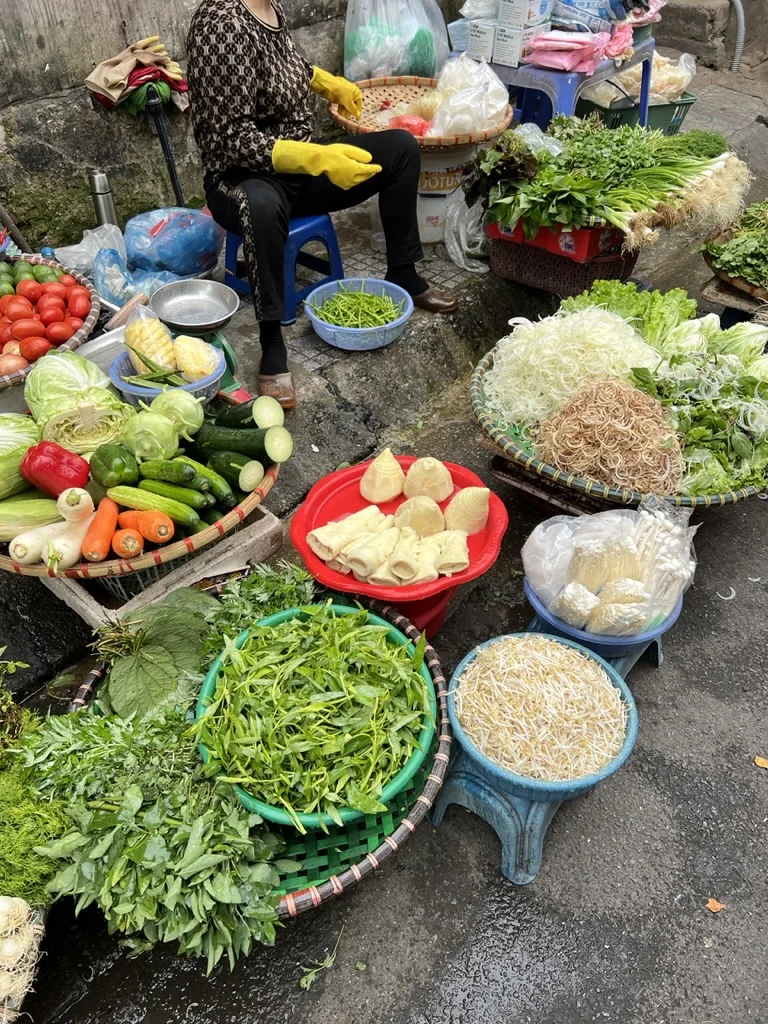
Unlike the U.S. where we have large department stores that have everything you could possibly need in one store, that is not the case in Vietnam. They really don’t have grocery stores either.
You will find some grocery stores in the big cities, but they still might not be that easy to get to. And this is mainly catered to tourists and not how the locals shop.
If you are looking for groceries, you will need to head to the local markets located around town. Or find little vendors driving around produce and snacks on their motorbikes.
For other toiletries, you might just need to walk around the city and find little local convenience stores.
Tampons Can Be Challenging To Find
For my lady friends, tampons are a little harder to find in Vietnam. You can likely find pads, but tampons are not very common. I would suggest trying to pack enough tampons for your extended travel or consider using a menstrual cup instead.
You Might Want To Think Twice About Renting A Motorbike In The Big Cities
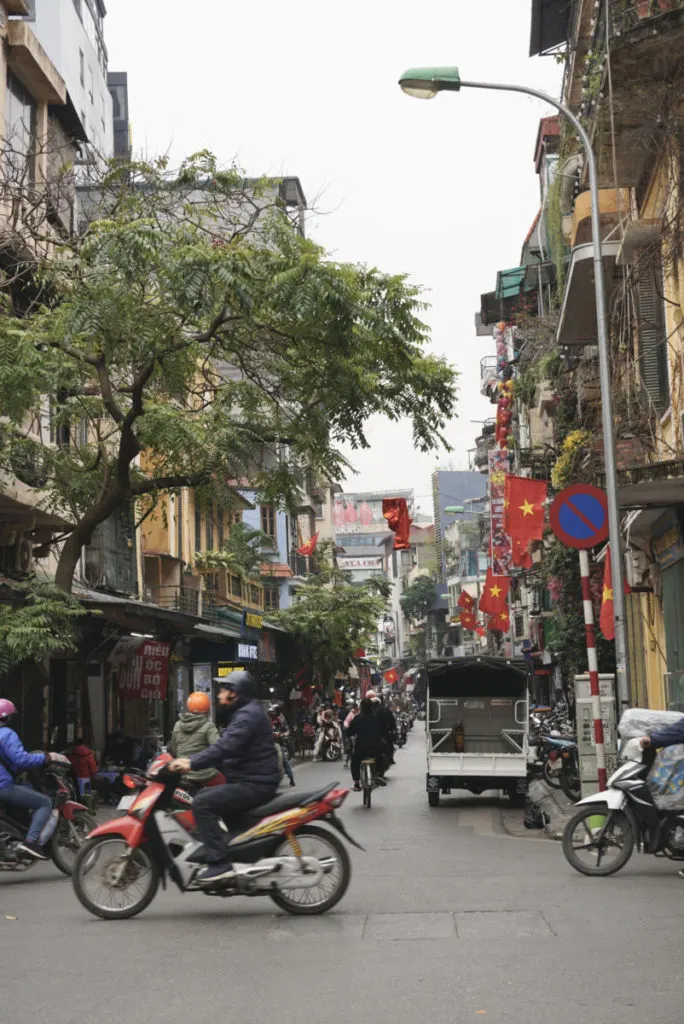
Motorbikes are certainly a way of life in Vietnam. But a huge culture shock for us when traveling to Vietnam was the traffic and driving.
It is like a free-for-all when it comes to the road. Intersections in the city aren’t really moderated by traffic lights. People just kinda yield on their own and cars and bikes are going every which direction.
The stereotype of “Asians are bad drivers” will start to make more sense once you see what the norms are here. Haha!
Unlike in the U.S. where turning onto a busy road, it is your responsibility to find the right moment to pull out or merge. In Vietnam, it works the opposite way.
It’s basically your responsibility to not hit someone turning out onto the busy road. Vietnamese people will pull out even if it means you have to slam your brakes. Or as we call it in the US, cutting people off, haha.
Luckily the speeds aren’t super fast in the bigger cities, but it just feels pretty unsafe. And it can be really intimidating to drive in.
If you do decide to rent a motorbike, be sure to get a helmet! Use common sense and definitely drive with extreme caution.
It’s Cheap To Travel Domestically
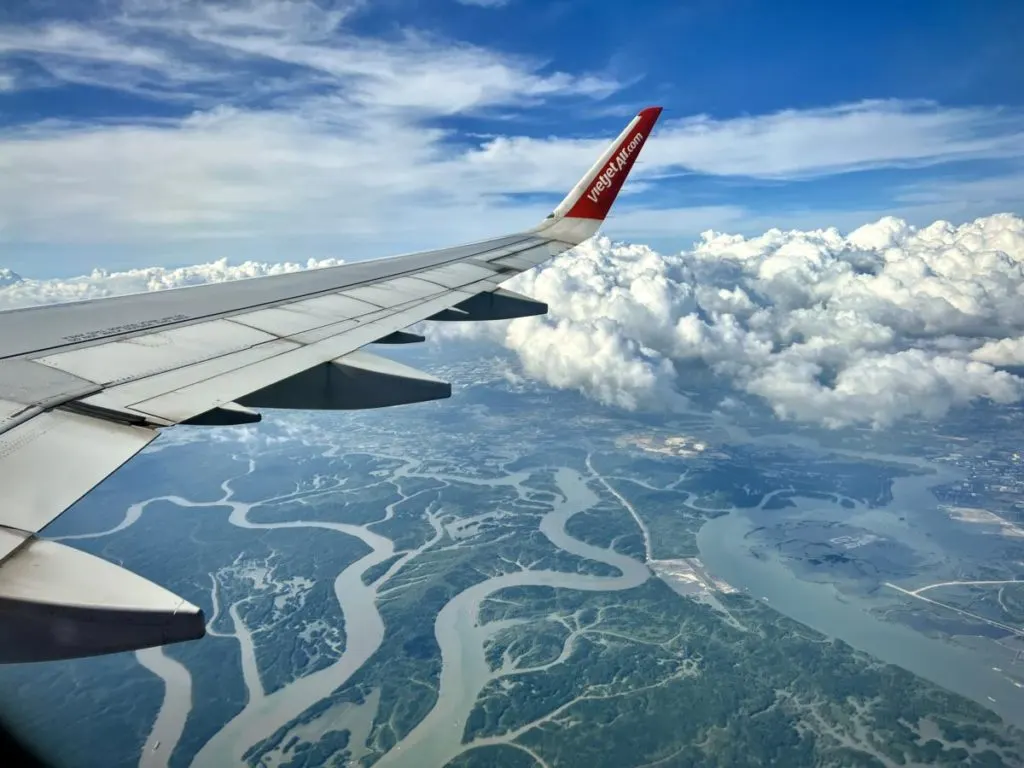
Domestic travel is way cheaper than the flight to get to and from the country. You can often find domestic flights from Northern Vietnam to Southern Vietnam for as little as $29 one way.
Same goes for train and bus travel to and from cities. Some bus tickets can be just a couple of dollars. We used the website 12goAsia to find cheap travel around Vietnam.
Takeaway | Things To Know Before Traveling To Vietnam
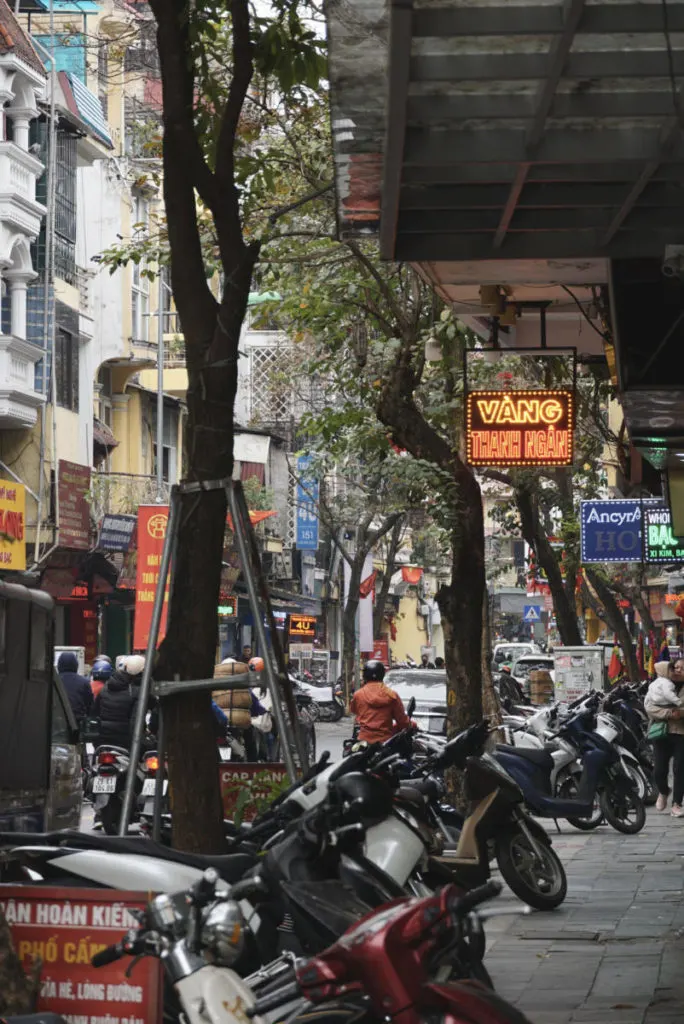
Traveling to Vietnam can be a little intimidating, especially if it’s your first country in Southeast Asia. But overall, Vietnam is a pretty safe country. We never felt unsafe when traveling around the country and the Vietnamese people were pretty friendly and willing to help you.
Some of the most important things to prepare yourself when traveling to Vietnam are to apply for a visa, have the local currency, download Google Translate and Grab, and have a way to use your phone in the country. If you come prepared with these, you will likely be starting your trip off on the right foot!
Stay tuned for tons more Vietnam content coming soon!
Save These ’33 Things To Know Before Traveling To Vietnam’ For Later
